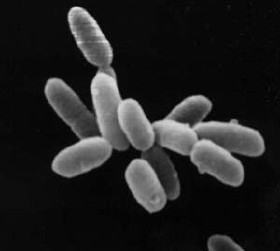- A hypothesis has been put forth in a paper by astrobiologists McKay and Smith (link provided below), that methanogenic (methane-producing) microbes (methanogens) may live in the (surface) hydrocarbon bodies of liquid (lakes) of Titan, using methane as a solvent (as well as, like all methanogens, producing methane as a result of metabolic processes).
- Hypothetically, such microbes could obtain energy by oxidizing complex hydrocarbons (such as acetylene (C2H2) and ethane (C2H6) in the seas using elemental hydrogen (H2), producing methane (CH4) as a waste product.
- To explain this a bit further, methanogenic microbes are anaerobic (not elemental oxygen-using), but derive energy by oxidizing carbon-containing compounds. Aerobic organisms also derive energy from carbon-containing compounds, but they may use elemental oxygen. Methanogenic microbes, rather than using elemental oxygen (as the oxidizer or electron donor in the reactions) may use elemental hydrogen (H2). This is a form of anaerobic metabolism, and one of the waste products of it is methane (CH4). For example, specifically, in the paper by McKay and Smith, hypothetical energy-producing reactions by methanogens on Titan could include:
- C2H2 + 3H2 = 2CH4 and
- C2H6 + H2 = 2CH4
- Some studies have suggested lower concentrations of elemental hydrogen (H2) and acetylene (C2H2) near the surface of Titan. One intriguing possible explanation for this could be the action of the hypothesized methanogenic microbes.
- Resources include: http://en.wikipedia.org/wiki/Hypothetical_types_of_biochemisty, and http://astrobiology.jhu.edu/wp-content/uploads/2010/06/Icarus-2005-McKay.pdf

© 2015 Fosdick EDS ☾><(((°>
